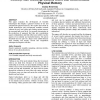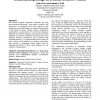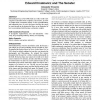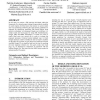CANDC
2005
ACM
14 years 1 months ago
2005
ACM
This paper examines the development of wearable technologies that display a garment’s history of use and communicate physical memory. We explore how trends in digital technologi...
CANDC
2005
ACM
14 years 1 months ago
2005
ACM
The Exhibition Cybernetic Serendipity (London 1968) is often considered to be the first major exhibition of computer art. Nearly forgotten, is an exhibition in Zagreb that also to...
CANDC
2005
ACM
14 years 1 months ago
2005
ACM
Ambience and immersive technological environments allow us to explore some basics of human pragmatics that lie beyond linguistics, intentionality and the subject-agency perspectiv...
CANDC
2005
ACM
14 years 1 months ago
2005
ACM
The Human-Computer Interaction community has long been concerned with design. Terms such as ‘creativity’ and ‘innovation’ are frequently used when referring to the design ...
CANDC
2005
ACM
14 years 1 months ago
2005
ACM
The story of some early computer art drawings in 1965 is told. It is a story of randomness. Computer art is viewed here as the programming of classes of aesthetic objects. In the ...
CANDC
2005
ACM
14 years 1 months ago
2005
ACM
Edward Ihnatowicz (1926-1988) built one of the world’s first computer-controlled robotic sculptures, The Senster, in 196870. Rather than concentrate entirely on this groundbreak...
CANDC
2005
ACM
14 years 1 months ago
2005
ACM
In this paper, we describe the origins, thematics, projects and practices of the art research collective Sponge. In particular, we focus on Sponge as a useful case study in transd...
ASSETS
2006
ACM
14 years 1 months ago
2006
ACM
ASSETS
2005
ACM
14 years 1 months ago
2005
ACM
We present various adaptations of the EdgeWrite unistroke text entry method that work on multiple computer input devices: styluses, touchpads, displacement and isometric joysticks...
ASSETS
2005
ACM
14 years 1 months ago
2005
ACM
Participatory research methods are being used internationally to gather data on complex social, cultural, and political concerns that effect the use of technology [4]. Researchers...




